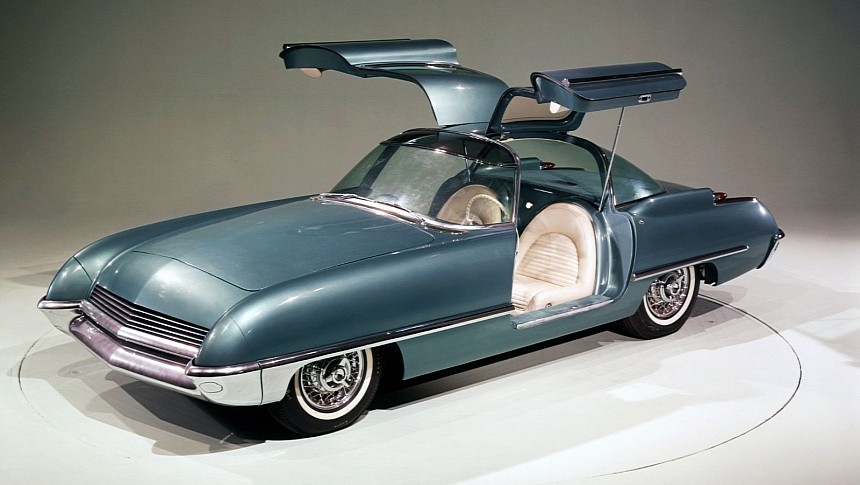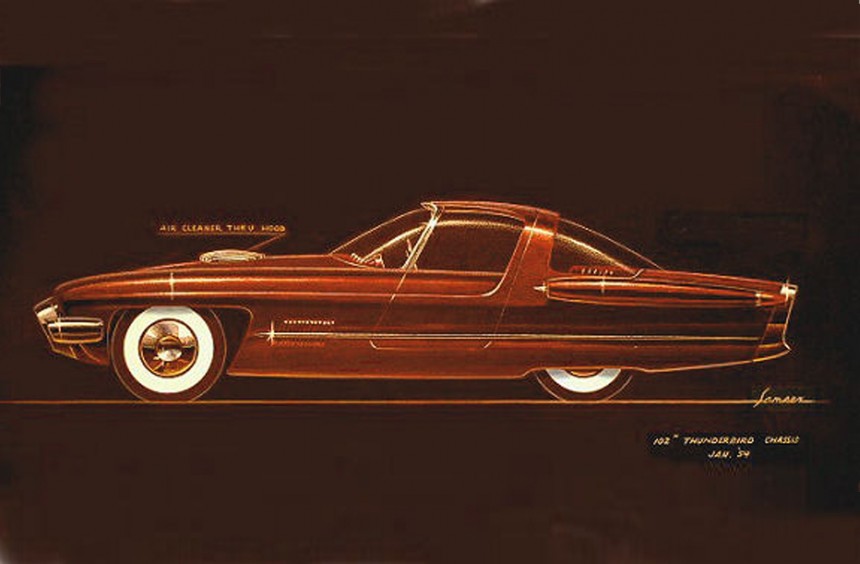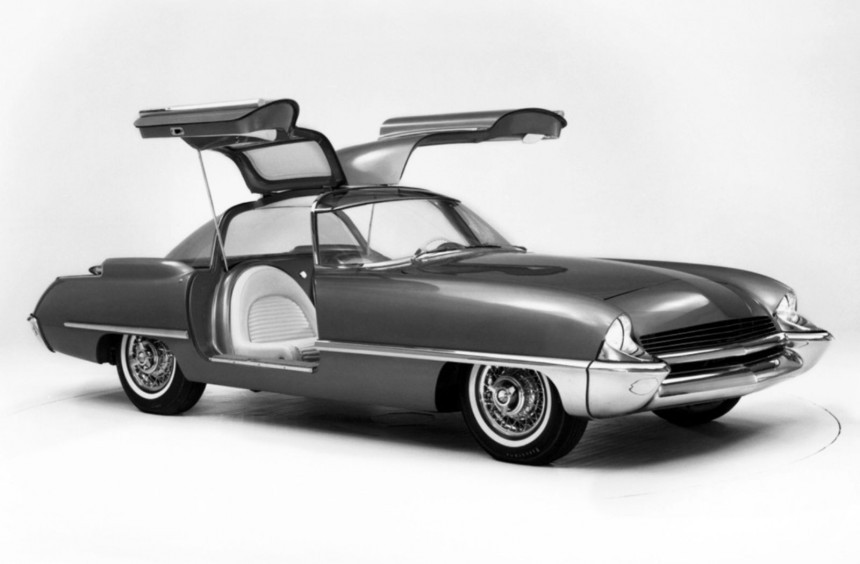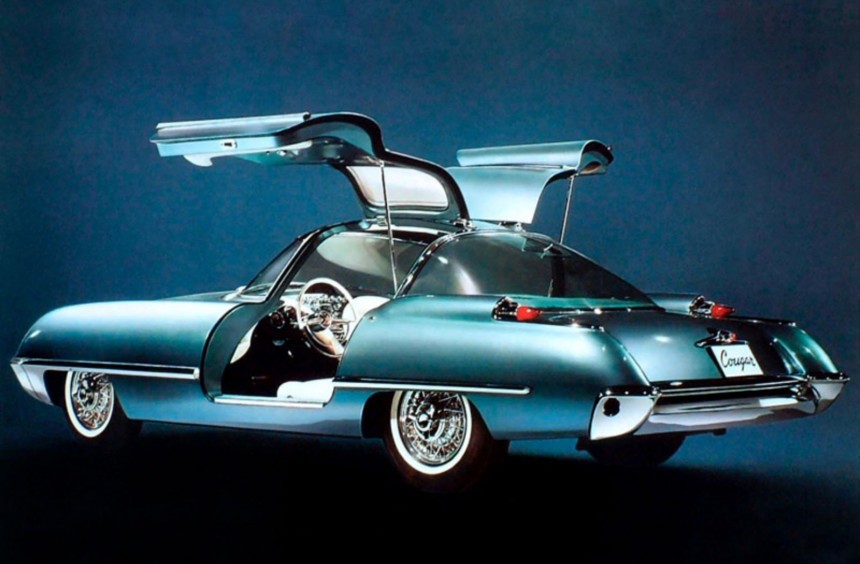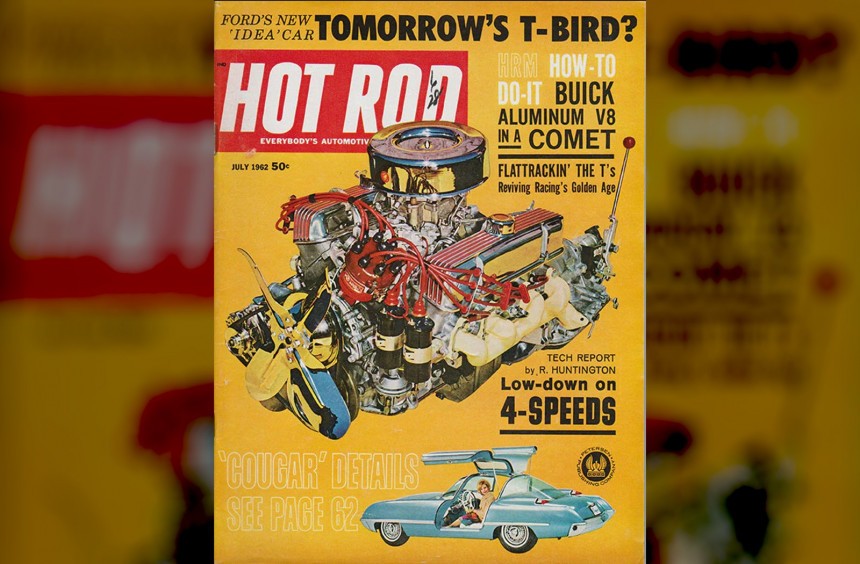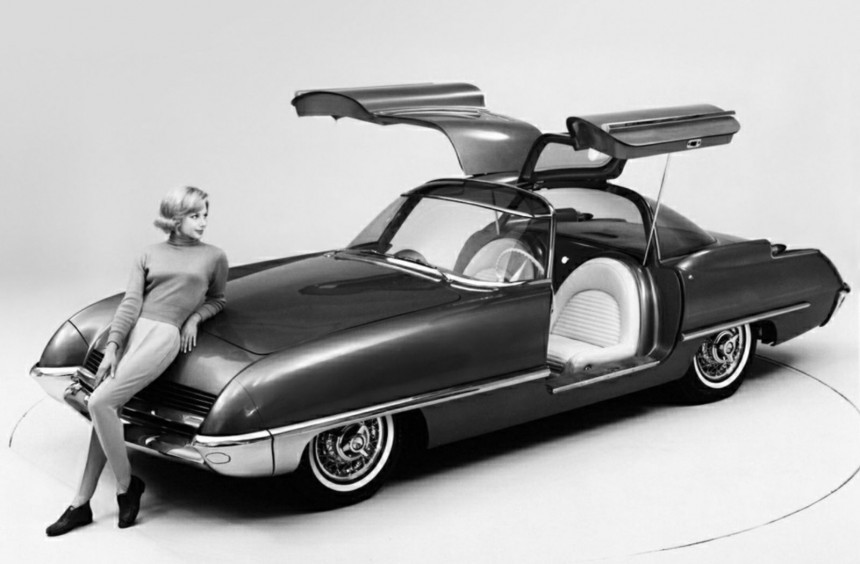A few years before the Cougar became the Mustang's upscale, Mercury-badged pony car sibling, the nameplate was used for a glamorous concept with gullwing doors and a massive V8.
Ever since the Harley J. Earl-designed Buick Y-Job was unveiled in 1938, the idea of creating one-offs that showcased futuristic design languages, new engines, and/or novel features became widespread in the automotive industry.
American carmakers started calling these vehicles "dream cars" (GM) or "idea cars" (Ford) and built them in large numbers during the 1960s and 1970s.
Excluding the Y-Job, some of the most famous American concept cars of the 20th century were the 1951 General Motors LeSabre, 1955 Lincoln Futura, 1957 Ford Nucleon, or the 1965 Corvette Mako Shark II.
As you can tell, Ford was at the forefront of the concept car craze, but apart from the two legends mentioned above, the Blue Oval also developed a fascinating yet enigmatic concept during the 1950s and 1960s: the Cougar 406.
In 1952, Ford added John R. "Dick" Samsen to its design team. A former aerospace engineer, Samsen would go on to sketch the 1955 Thunderbird and, after leaving Ford for crosstown rivals Chrysler, he helped co-design popular Plymouth models like the Barracuda, Fury, Road Runner, Imperial, or Duster.
While still at Ford, months before the gorgeous Thunderbird was introduced to the public, Samsen decided to take the design to another level.
He proposed an even more luxury-oriented version of the T-Bird, one that could rival the Mercedes-Benz 300 SL, which was extremely popular among affluent American buyers.
Samsen put together a series of sketches that included eye-catching, aircraft-inspired styling cues, a hood with an opening for a tall-deck V8's air cleaner, and gullwing doors inspired by the German grand tourer.
While Samsen left Ford for Chrysler in 1955, the styling department was given the go-ahead to create a 3/8-scale model of his ambitious design about a year later.
But, after the model was completed, Ford executives shelved the project and redirected the department's resources to other designs.
For the next five years, the scale model gathered dust in a storage facility, but as Ford wanted to introduce a new Gen 2 FE engine, the company decided to resurrect Samsen 's intriguing design.
The scale model was dusted off, and along with the original sketches, it was sent to renowned Los Angeles-based custom car builder Dean Jeffries, who was commissioned to turn it into a fully functional car.
Jeffries sourced a third-gen Thunderbird chassis and the brand-new 406-ci (6.6-liter) V8 from Ford and began constructing the car.
Since the original Samsen sketches were based on the first-gen T-Bird, the famous builder made several changes to accommodate the longer chassis and bring it closer to the design trends of the early sixties.
A stunning "idea car"
Completed in just a few months and christened Cougar, the show car received a beautiful handcrafted body.
Compared to the original sketches and scale model, the real car featured more streamlined curves.
At the front, it received hidden headlights with covers that dropped down into the bumper at the push of a button.
At the rear, two small fins with built-in stoplights located on top of each quarter panel paid homage to Samsen's original 1954 design. Unfortunately, the stylist's hotrod-style hood didn't make it, probably because Ford didn't want to modify the 403 engine.
But, unquestionably, the car's defining feature was the set of gullwing-opening doors.
Rumors had it that Jeffries took to 300 SL doors and modified them for the Cougar, but judging by their fundamentally different shape, that's less than likely.
The Cougar debuted at the 1962 Chicago Auto Show, where the public and press praised its stunning design and the potent 406 engine rated at 405 hp thanks to three Holley two-barrel carbs.
Later that year, Hot Rod magazine featured the idea car in its July issue, highlighting its gullwing doors and powerful V8. Moreover, it made the magazine's cover with the question, "Tomorrow's T-Bird?".
Though the Cougar wasn't conceived to replace the third-gen Thunderbird or make it into production as a new model, it did make it on the big screen.
Repainted in a bright shade of red, the beautiful two-seater was featured in the 1963 comedy "Under the Yum Yum Tree" starring Jack Lemmon, Carol Lynley, Dean Jones, and Edie Adams.
In the movie, it was used as a daily driver by one of the main characters, Hogan, a swinging bachelor and master con man.
Few details about this beautiful concept exist today, so what happened to it after filming concluded is shrouded in mystery.
At the time, carmakers usually destroyed such concepts after they served their purpose, but rumors have it that a wealthy collector purchased the Cugar.
However, since there's no information about its whereabouts today, it's unclear if Ford's gullwing wonder has survived.
One thing's for sure: the nameplate lived on. It was used on another Ford concept in 1963, and then it was attributed to Mercury's new pony car, which became the brand's best-selling production model.
The nameplate was also used by a Ford production car from 1998 to 2001, the eight-generation Mercury Cougar, marketed in Europe with Blue Oval badges.
American carmakers started calling these vehicles "dream cars" (GM) or "idea cars" (Ford) and built them in large numbers during the 1960s and 1970s.
Excluding the Y-Job, some of the most famous American concept cars of the 20th century were the 1951 General Motors LeSabre, 1955 Lincoln Futura, 1957 Ford Nucleon, or the 1965 Corvette Mako Shark II.
As you can tell, Ford was at the forefront of the concept car craze, but apart from the two legends mentioned above, the Blue Oval also developed a fascinating yet enigmatic concept during the 1950s and 1960s: the Cougar 406.
It started life as a scale model
While still at Ford, months before the gorgeous Thunderbird was introduced to the public, Samsen decided to take the design to another level.
He proposed an even more luxury-oriented version of the T-Bird, one that could rival the Mercedes-Benz 300 SL, which was extremely popular among affluent American buyers.
Samsen put together a series of sketches that included eye-catching, aircraft-inspired styling cues, a hood with an opening for a tall-deck V8's air cleaner, and gullwing doors inspired by the German grand tourer.
While Samsen left Ford for Chrysler in 1955, the styling department was given the go-ahead to create a 3/8-scale model of his ambitious design about a year later.
But, after the model was completed, Ford executives shelved the project and redirected the department's resources to other designs.
The revival
The scale model was dusted off, and along with the original sketches, it was sent to renowned Los Angeles-based custom car builder Dean Jeffries, who was commissioned to turn it into a fully functional car.
Jeffries sourced a third-gen Thunderbird chassis and the brand-new 406-ci (6.6-liter) V8 from Ford and began constructing the car.
Since the original Samsen sketches were based on the first-gen T-Bird, the famous builder made several changes to accommodate the longer chassis and bring it closer to the design trends of the early sixties.
A stunning "idea car"
Compared to the original sketches and scale model, the real car featured more streamlined curves.
At the front, it received hidden headlights with covers that dropped down into the bumper at the push of a button.
At the rear, two small fins with built-in stoplights located on top of each quarter panel paid homage to Samsen's original 1954 design. Unfortunately, the stylist's hotrod-style hood didn't make it, probably because Ford didn't want to modify the 403 engine.
But, unquestionably, the car's defining feature was the set of gullwing-opening doors.
Rumors had it that Jeffries took to 300 SL doors and modified them for the Cougar, but judging by their fundamentally different shape, that's less than likely.
From show car to movie and magazine cover star
Later that year, Hot Rod magazine featured the idea car in its July issue, highlighting its gullwing doors and powerful V8. Moreover, it made the magazine's cover with the question, "Tomorrow's T-Bird?".
Though the Cougar wasn't conceived to replace the third-gen Thunderbird or make it into production as a new model, it did make it on the big screen.
Repainted in a bright shade of red, the beautiful two-seater was featured in the 1963 comedy "Under the Yum Yum Tree" starring Jack Lemmon, Carol Lynley, Dean Jones, and Edie Adams.
In the movie, it was used as a daily driver by one of the main characters, Hogan, a swinging bachelor and master con man.
The nameplate lived on
At the time, carmakers usually destroyed such concepts after they served their purpose, but rumors have it that a wealthy collector purchased the Cugar.
However, since there's no information about its whereabouts today, it's unclear if Ford's gullwing wonder has survived.
One thing's for sure: the nameplate lived on. It was used on another Ford concept in 1963, and then it was attributed to Mercury's new pony car, which became the brand's best-selling production model.
The nameplate was also used by a Ford production car from 1998 to 2001, the eight-generation Mercury Cougar, marketed in Europe with Blue Oval badges.
